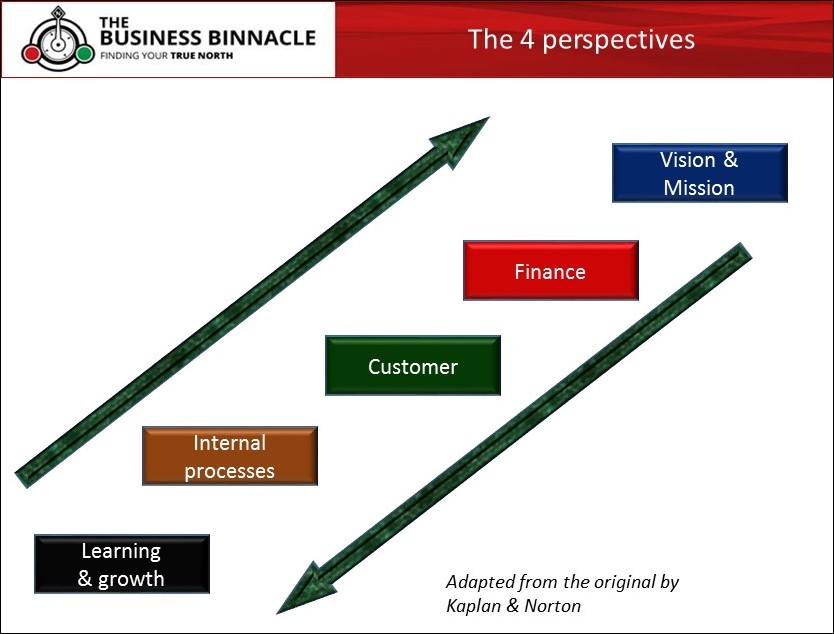The balanced scorecard is a technique used for managing a company’s performance across 4 key perspectives…
- Learning and Growth
- Internal Processes
- Customer Perspective
- Financial Perspective
The original Kaplan Norton balanced scorecard has undergone several generational changes from the time it was first presented in the early ’90s.
Current balanced scorecards in use in the marketplace are sometimes referred to as Third Generation Scorecards (or 3G Balanced Scorecards), as they incorporate the learning from the successes and failures in implementing scorecards over the years across the international marketplace and a wide range of industry sectors.
Third generation scorecards incorporate a number of additional techniques including the design of destination statements for choosing strategic objectives and even the selection of measures and targets from the experience of dot.com industry. The balanced scorecard in its third generation format includes such diverse and essential tools as strategy mapping and measuring wealth through overarching measures like economic value added, etc.
Key benefits from managing performance using a third generational scorecard are…
- They translate the firms strategy into measurable parameters.
- They communicate the strategy to all staff in the firm and allow them to contribute to the planning and to take ownership of the strategies of the firm.
- They align the individual goals of employees with the firm’s strategic objectives; third generation scorecards recognise that the selected measures influence the behaviour of employees.
- Feedback from the scorecard implementation is incorporated into the strategic planning process.
The Business Binnacle specialises in managing performance and in designing 3rd/4th Generation Balanced Scorecards, Strategy Mapping and Destination Planning for small and large companies in New Zealand.

The original balanced scorecard was designed by Kaplan & Norton in the early 90s as a technique to drive performance management to achieve the firms strategic objectives by monitoring activities and measures across four perspectives, namely: learning, internal business processes, the customer and finance. The underlying logic of the balanced scorecard was that these 4 perspectives would provide a snapshot of the leading and lagging indicators of performance to align people (learning agenda), processes, customers (value proposition) and financial measures with the mission and strategic objectives of the firm (internal business processes).
Balanced scorecards have been through several generational changes over the years chronicled in part by Olve (1999), Shulver (2000) and in some depth by Cobbold and Lawrie (2002). A short synopsis of the history of the generational changes in scorecarding is provided below:
Kaplan Norton’s original scorecards (Cobbold and Lawrie, 2002) morphed into their 2nd generation with the use of Strategy Mapping a technique designed by Kaplan Norton to map key strategic themes which were concurrently made hugely popular by the IT industry.
The third generation of scorecards incorporated the use of Destination Statements. Destination Statements allowed scorecards to cascade down to the lowest reaches of management.
Standard 3G Balanced Scorecards tend to be fairly sophisticated in their own right, depending on the type of organisation and the processes and measures needed. Many of them use overarching measures like Economic Value Added and a few other similar value-added measures/techniques.
3rd generational scorecards sometimes morph into 4th Generation Balanced Scorecards (4G Balanced Scorecards) to address leakages caused by the changes in the traditional manner in which scorecards have operated.
A 21st century firm operates across a regional and often global supply chain to serve demand from customers that are both local and international. Measuring performance that by definition is co-dependant on the performance of outsourced supply partners is a challenge, particularly when competing firms co-operate and compete in the same market at the same time. Scorecards that amalgamate the SCOR system and the impact of supply chain alliances form part of this technique.
Other complications come from the need for organisations to demonstrate both corporate social and environmental responsibility and measure their environmental footprint against wealth creation for their shareholders and a find a via media that manages this conflict. The need to constantly innovate, in turn creating short product service life cycles along with the need to measure investment that by definition provide no tangible returns in a reasonable horizon, challenge the very concept of performance measurement.
Typical scorecards at the 3G-4G level tend to focus on managing conflicting requirements within and outside the firm at its value interfaces and encompass both the traditional and innovatory methods of capturing performance…
- They Provide a ‘value advisory service’, that links the performance outcomes of the scorecard (in the customer and finance perspectives) to the earnings valuation of the company, but also measure the value gap from the dyadic boundaries of the strategic alliances that the firm embarks on. Many of these lie on the global supply chain of the firm.
- These scorecards measure the impact of the firm’s current strategies on the community and the environment (including climate change). This is particularly important as a number of market-based firms are required to report activities instead of achievements when they speak of their environmental and ecological footprints.
- They address typical problems that have bedevilled earlier scorecards by measuring and managing such areas as IT portfolio management and brand value management.
- They translate the firm’s strategy into measurable parameters.
- They communicate the strategy to all staff in the firm and allow them to contribute to the planning and to take ownership of the strategies of the firm.
- They align the individual goals of employees with the firm’s strategic objectives. Third generation scorecards recognise that the selected measures influence the behaviour of employees.
- Feedback from the scorecard implementation is incorporated into the strategic planning process.
Allan Rodrigues of The Business Binnacle has designed a methodology called The Business Compass to capture the processes, measures and learning of the 3G/4G scorecard.
The Business Compass is based on separate scorecards measuring strategic alliances, share value, environmental sustainability and community footprints and impact measures.
You can contact Allan at allan@theBusinessBinnacle.co.nz [no spam]
Next…
